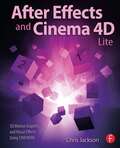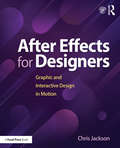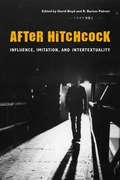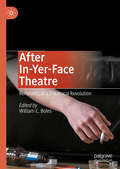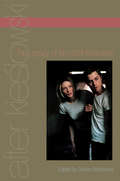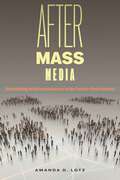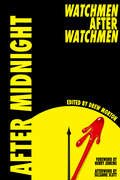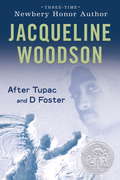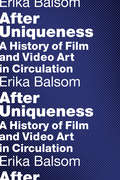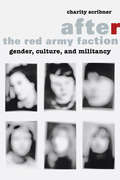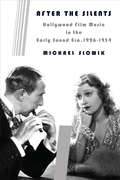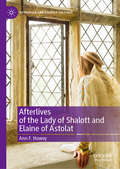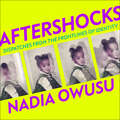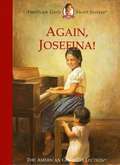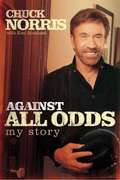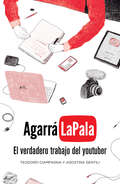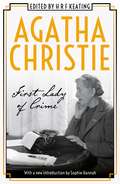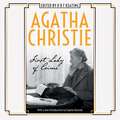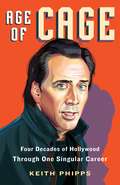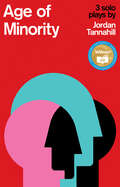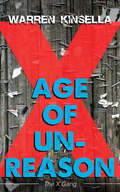- Table View
- List View
After Effects and Cinema 4D Lite: 3D Motion Graphics and Visual Effects Using CINEWARE
by Chris JacksonOne of the most exciting new features in After Effects is the integration of Cinema 4D using the CINEWARE plug-in and a free version of Cinema 4D Lite. Both provide a wide assortment of new 3D tools and options that are difficult or nearly impossible to achieve in After Effects alone. This book clearly demonstrates how the new 3D workflow bridges the two applications together to raise the design bar for motion graphics and broadcast design. Hands-on exercises teach you essential production skills including: Modeling in CINEMA 4D Lite Importing 3D models in After Effects Tracking 3D motion in After Effects Compositing with CINEWARE Using MoGraph features in CINEMA 4D Rendering and optimization techniques Additional online materials include project files and videos showcasing the techniques covered in the book. To access these materials, please see the 'eResources' tab.
After Effects for Designers: Graphic and Interactive Design in Motion
by Chris JacksonAfter Effects for Designers teaches design students, artists, and web, graphic, and interactive designers how to design, develop, and deploy motion design projects using Adobe After Effects. Author Chris Jackson balances fundamental aspects of time-based design with related techniques, and explores the principles of animation; composition and layout; visual hierarchy; typography; cinematic storytelling; 3D modelling; compositing, and more. Each chapter contains unique, step-by-step project exercises that offer timesaving practical tips and hands-on design techniques, teaching readers how to effectively use the tools at their disposal in order to conceptualize and visualize creative solutions to their own motion design work. Readers will build professional-world examples in every chapter and, as a result, learn how to both design effectively using After Effects and practically apply these skills in client-based work. An accompanying companion website includes complete project files for the book's chapter exercises, and additional video tutorials.
After Hitchcock: Influence, Imitation, and Intertextuality
by Palmer David Boyd R. BartonAlfred Hitchcock is arguably the most famous director to have ever made a film. Almost single-handedly he turned the suspense thriller into one of the most popular film genres of all time, while his Psycho updated the horror film and inspired two generations of directors to imitate and adapt this most Hitchcockian of movies. Yet while much scholarly and popular attention has focused on the director's oeuvre, until now there has been no extensive study of how Alfred Hitchcock's films and methods have affected and transformed the history of the film medium. In this book, thirteen original essays by leading film scholars reveal the richness and variety of Alfred Hitchcock's legacy as they trace his shaping influence on particular films, filmmakers, genres, and even on film criticism. Some essays concentrate on films that imitate Hitchcock in diverse ways, including the movies of Brian de Palma and thrillers such as True Lies, The Silence of the Lambs, and Dead Again. Other essays look at genres that have been influenced by Hitchcock's work, including the 1970s paranoid thriller, the Italian giallo film, and the post-Psycho horror film. The remaining essays investigate developments within film culture and academic film study, including the enthusiasm of French New Wave filmmakers for Hitchcock's work, his influence on the filmic representation of violence in the post-studio Hollywood era, and the ways in which his films have become central texts for film theorists.
After In-Yer-Face Theatre: Remnants of a Theatrical Revolution
by William C. BolesThis book revisits In-Yer-Face theatre, an explosive, energetic theatrical movement from the 1990s that introduced the world to playwrights Sarah Kane, Martin McDonagh, Mark Ravenhill, Jez Butterworth, and many others. Split into three sections the book re-examines the era, considers the movement’s influence on international theatre, and considers its lasting effects on contemporary British theatre. The first section offers new readings on works from that time period (Antony Neilson and Mark Ravenhill) as well as challenges myths created by the Royal Court Theatre about the its involvement with In-Yer-Face theatre. The second section discusses the influence of In-Yer-Face on Portuguese, Russian and Australian theater, while the final section discusses the legacy of In-Yer-Face writers as well as their influences on more recent playwrights, including chapters on Philip Ridley, Sarah Kane, Joe Penhall, Martin Crimp, Dennis Kelly, and Verbatim Drama.
After Kieślowski: The Legacy of Krzysztof Kieślowski
by Steven WoodwardTraces the legacy of Krzysztof Kieslowski in films made after his death using his scripts or ideas and in the work of other filmmakers.
After Mass Media: Storytelling for Microaudiences in the Twenty-First Century (Critical Cultural Communication)
by Amanda D. LotzExplores the cultural role of screen storytelling in societyWith significant evolutions in digital technologies and media distribution in the past two decades, the business of storytelling through screens has shifted dramatically. In the past, blockbuster movies and TV shows like Friends aimed first for domestic mass audiences, although the biggest hits circulated globally. Now, transnational distribution plays a primary role and imagined audiences are global. At the same time, the once-mass audience has significantly fragmented to enable an expansion in the range of commercially viable stories, as evident in series as varied as Atlanta, Better Things, and dozens of others that are not widely known, but deeply loved by their microaudiences.Delving into the changing landscape of commercial screen storytelling, After Mass Media explores how industrial shifts and technological advancements have remade the narrative landscape over the past two decades. Television and movies have long shaped society, whether by telling us about the worlds around us or far away. By examining the internationalization of screen businesses, the rise of streaming services with multi-territory reach, and the stories made for this environment, this book sheds light on the profound transformations in television and film production and circulation. With a keen focus on major changes in the types of screen stories being told, Amanda D. Lotz unravels the industrial roots that made these transformations possible, challenges some conventional distinctions of screen storytelling, and provides new conceptual tools to make sense of the abundance and range of screen stories on offer.Through its comprehensive analysis, After Mass Media exposes how contemporary industrial dynamics, particularly the erosion of traditional distribution models based on geography and mass audience reach, have far-reaching implications for our understanding of national video cultures.
After Midnight: Watchmen after Watchmen
by Suzanne ScottContributions by Apryl Alexander, Alisia Grace Chase, Brian Faucette, Laura E. Felschow, Lindsay Hallam, Rusty Hatchell, Dru Jeffries, Henry Jenkins, Jeffrey SJ Kirchoff, Curtis Marez, James Denis McGlynn, Brandy Monk-Payton, Chamara Moore, Drew Morton, Mark C. E. Peterson, Jayson Quearry, Zachary J. A. Rondinelli, Suzanne Scott, David Stanley, Sarah Pawlak Stanley, Tracy Vozar, and Chris Yogerst Alan Moore and Dave Gibbons’s Watchmen fundamentally altered the perception of American comic books and remains one of the medium’s greatest hits. Launched in 1986—“the year that changed comics” for most scholars in comics studies—Watchmen quickly assisted in cementing the legacy that comics were a serious form of literature no longer defined by the Comics Code era of funny animal and innocuous superhero books that appealed mainly to children. After Midnight: “Watchmen” after “Watchmen” looks specifically at the three adaptations of Moore and Gibbons’s Watchmen—Zack Snyder’s Watchmen film (2009), Geoff Johns’s comic book sequel Doomsday Clock (2017), and Damon Lindelof’s Watchmen series on HBO (2019). Divided into three parts, the anthology considers how the sequels, especially the limited series, have prompted a reevaluation of the original text and successfully harnessed the politics of the contemporary moment into a potent relevancy. The first part considers the various texts through conceptions of adaptation, remediation, and transmedia storytelling. Part two considers the HBO series through its thematic focus on the relationship between American history and African American trauma by analyzing how the show critiques the alt-right, represents intergenerational trauma, illustrates alternative possibilities for Black representation, and complicates our understanding of how the mechanics of the show’s production can impact its politics. Finally, the book’s last section considers the themes of nostalgia and trauma, both firmly rooted in the original Moore and Gibbons series, and how the sequel texts reflect and refract upon those often-intertwined phenomena.
After Tupac and D Foster
by Jacqueline WoodsonD Foster showed up a few months before Tupac got shot that first time and left us the summer before he died. <P><P> The day D Foster enters Neeka and her best friend's lives, the world opens up for them. D comes from a world vastly different from their safe Queens neighborhood, and through her, the girls see another side of life that includes loss, foster families and an amount of freedom that makes the girls envious. Although all of them are crazy about Tupac Shakur's rap music, D is the one who truly understands the place where he's coming from, and through knowing D, Tupac's lyrics become more personal for all of them. The girls are thirteen when D's mom swoops in to reclaim D--and as magically as she appeared, she now disappears from their lives. Tupac is gone, too, after another shooting; this time fatal. As the narrator looks back, she sees lives suspended in time, and realizes that even all-too-brief connections can touch deeply. <P> A Discussion Guide to After Tupac and D Foster by Jacqueline Woodson .<P> Newbery Honor book
After Uniqueness: A History of Film and Video Art in Circulation (Film and Culture Series)
by Erika BalsomImages have never been as freely circulated as they are today. They have also never been so tightly controlled. As with the birth of photography, digital reproduction has created new possibilities for the duplication and consumption of images, offering greater dissemination and access. But digital reproduction has also stoked new anxieties concerning authenticity and ownership. From this contemporary vantage point, After Uniqueness traces the ambivalence of reproducibility through the intersecting histories of experimental cinema and the moving image in art, examining how artists, filmmakers, and theorists have found in the copy a utopian promise or a dangerous inauthenticity—or both at once. <P><P>From the sale of film in limited editions on the art market to the downloading of bootlegs, from the singularity of live cinema to video art broadcast on television, Erika Balsom investigates how the reproducibility of the moving image has been embraced, rejected, and negotiated by major figures including Stan Brakhage, Leo Castelli, and Gregory Markopoulos. Through a comparative analysis of selected distribution models and key case studies, she demonstrates how the question of image circulation is central to the history of film and video art. After Uniqueness shows that distribution channels are more than neutral pathways; they determine how we encounter, interpret, and write the history of the moving image as an art form.
After the Dancing Days
by Margaret I. RostkowskiFrom the Bookjacket: Ages 11-14 So much had changed in one year One year ago, I believed my mother knew everything and that I would never have cause to disobey her. I knew my father could heal anyone And I thought Uncle Paul had died in glory. Thirteen-year-old Annie waits at the train station for her father, a doctor. It is 1919, the Great War is over, and the wounded are returning to a small town near Kansas City from the battlefields of France. When her father decides to continue his work at the veterans' hospital, Annie finds she is drawn to the place for reasons she doesn't understand. There she meets Andrew, a horribly burned young veteran who is bitterly withdrawn from all around him. Acting against the express wishes of her strong-willed mother, Annie continues to visit the hospital, helping Andrew come out of his shell. Together they discover the devastating truth about Uncle Paul's death. Then Annie must confront her mother's anger and the ironies of heroism. AFTER THE DANCING DAYS is a timeless first novel about a young girl's first steps into the complex world of adulthood.
After the Red Army Faction
by Charity ScribnerAnalyzing the afterimage of revolutionary violence in contemporary culture and politics. Utopia or Auschwitz: Germany's 1968 Generation and the Holocaust
After the Red Army Faction: Gender, Culture, and Militancy
by Charity ScribnerMasterminded by women, the Red Army Faction (RAF) terrorized West Germany from the 1970s to the 1990s. Afterimages of its leaders persist in the works of pivotal artists and writers, including Gerhard Richter, Elfriede Jelinek, and Slavoj i ek. Why were women so prominent in the RAF? What does the continuing cultural response to the German armed struggle tell us about the representation of violence, power, and gender today? Engaging critical theory, Charity Scribner addresses these questions and analyzes signal works that point beyond militancy and terrorism. This literature and art discloses the failures of the Far Left and registers the radical potential that RAF women actually forfeited.After the Red Army Faction maps out a cultural history of militancy and introduces "postmilitancy" as a new critical term. <P><P>As Scribner demonstrates, the most compelling examples of postmilitant culture don't just repudiate militancy: these works investigate its horizons of possibility, particularly on the front of sexual politics. Objects of analysis include as-yet untranslated essays by Theodor Adorno and Jürgen Habermas, as well as novels by Friedrich Dürrenmatt and Judith Kuckart, Johann Kresnik's Tanztheaterstück Ulrike Meinhof, and the blockbuster exhibition Regarding Terror at the Berlin Kunst-Werke. Scribner focuses on German cinema, offering incisive interpretations of films by Margarethe von Trotta, Volker Schlöndorff, and Fatih Akin, as well as the international box-office success The Baader-Meinhof Complex. These readings disclose dynamic junctures among several fields of inquiry: national and sexual identity, the disciplining of the militant body, and the relationship between mass media and the arts.
After the Silents
by Michael SlowikViewing more than two hundred films from the period, Michael Slowik launches the first comprehensive study of a long-neglected phase in Hollywood's initial development
After the Silents: Hollywood Film Music in the Early Sound Era, 1926-1934 (Film and Culture Series)
by Michael SlowikMany believe Max Steiner's score for King Kong (1933) was the first important attempt at integrating background music into sound film, but a closer look at the industry's early sound era (1926–1934) reveals a more extended and fascinating story. Viewing more than two hundred films from the period, Michael Slowik launches the first comprehensive study of a long-neglected phase in Hollywood's initial development, recasting the history of film sound and its relationship to the "Golden Age" of film music (1935–1950). <P><P>Slowik follows filmmakers' shifting combinations of sound and image, recapturing the volatility of this era and the variety of film music strategies that were tested, abandoned, and kept. He explores early film music experiments and accompaniment practices in opera, melodrama, musicals, radio, and silent films and discusses the impact of the advent of synchronized dialogue. He concludes with a reassessment of King Kong and its groundbreaking approach to film music, challenging the film's place and importance in the timeline of sound achievement.
Afterimages
by Arlene CroceDancing leaves nothing else behind--no record, no text--and so the afterimage becomes the subject of dance criticism. A dance critic tries to train the memory as well as the organs of sense; he tries to make the afterimage that appears in his writing match the performance. 10 years of reviews of dancing, from ballet to Balanchine to Twyla Tharp.
Afterlives of the Lady of Shalott and Elaine of Astolat (Arthurian and Courtly Cultures)
by Ann F. HoweyThis book investigates adaptations of The Lady of Shalott and Elaine of Astolat in Victorian and post-Victorian popular culture to explore their engagement with medievalism, social constructions of gender, and representations of the role of art in society. Although the figure of Elaine first appeared in medieval texts, including Malory’s Le Morte Darthur, Tennyson’s poems about the Lady and Elaine drew unprecedented response from musicians, artists, and other authors, whose adaptations in some cases inspired further adaptations. With chapters on music, art, and literature (including parody, young people’s literature, and historical fiction and fantasy), this book seeks to trace the evolution of these characters and the ways in which they reinforce or challenge conventional gender roles, represent the present’s relationship to the past, and highlight the power of art.
Aftershocks: Dispatches from the Frontlines of Identity
by Nadia OwusuI have lived in disaster and disaster has lived in me. Our shared languages are thunder and reverberation.When Nadia Owusu was two years old her mother abandoned her and her baby sister and fled from Tanzania back to the US. When she was thirteen her beloved Ghanaian father died of cancer. She and her sister were left alone, with a stepmother they didn't like, adrift. Nadia Owusu is a woman of many languages, homelands and identities. She grew up in Rome, Dar-es-Salaam, Addis Ababa, Kumasi, Kampala and London. And for every new place there was a new language, a new identity and a new home. At times she has felt stateless, motherless and identity-less. At others, she has had multiple identities at war within her. It's no wonder she started to feel fault lines in her sense of self. It's no wonder that those fault lines eventually ruptured. Aftershocks is the account of how she hauled herself out of the wreckage. It is the intimate story behind the news of immigration and division dominating contemporary politics. Nadia Owusu's astonishingly moving and incredibly timely memoir is a nuanced portrait of globalisation from the inside in a fractured world in crisis.
Again Josefina (American Girls Short Stories #8)
by Valerie TrippAny child who has taken piano lessons will get a kick out of this book. Josefina finds unique ways to "practice," and even baby Antonio gets into the act of encouraging her to practice more. Humor, warmth, and lots of repetition lead Josefina to become a player of songs. Other books about Josefina are also available from Bookshare. In order for this file to make an excellent embossed braille copy, attention must be paid to the words written in Spanish.
Against All Odds
by Ken Abraham Chuck NorrisNorris describes himself as a shy youth who finally blossomed while studying martial arts as a soldier in South Korea. His self-deprecating humor shows through anecdotes about karate defeats, white-knuckled speaking engagements, and his failure to become a Los Angeles policeman, which led to his fame as a karate champion.
Agarrá la pala: El verdadero trabajo del youtuber
by Teodoro Ciampagna Alejandro Bacile¿Cuál es el verdadero trabajo del youtuber? Ellos mismos te lo cuentan. Mucho se habla de que los youtubers son un montón de vagos que hace pavadas frentes a una camarita. Lo cierto es que cambiaron el paradigma de la comunicación y son los dueños de la audiencia de todas las edades; cada uno con su talento particular. ¿Cuál es su verdadero trabajo? ¿Cuánto tiempo les lleva? ¿Por qué lo hacen? ¿Son todos amigos o hay rivalidades? Esas y muchas otras preguntas más son respondidas en este libro por los youtubers más importantes de la Argentina.
Agatha Christie: First Lady of Crime
by Agatha ChristieIncludes a new introduction from Sophie Hannah, bestselling author of THE MONOGRAM MURDERS and HAVEN'T THEY GROWNAgatha Christie was not only the biggest selling writer of detective stories the world has ever known, she was also a mystery in herself, giving only the rarest interviews, declining absolutely to become any sort of public figure, and a mystery too in the manner in which she achieved her astonishing success.H R F Keating, a crime novelist and respected reviewer of crime fiction, brought together a dozen distinguished writers from both sides of the Atlantic to throw light on this double mystery. Some analyse the art itself; some explain the reasons for her success, not just the books, but also in film and theatre.The approaches are penetrating, affectionate, enthusiastic, analytical, funny - even critical. Together, they give an almost unique insight into the life and work of the First Lady of Crime.
Agatha Christie: First Lady of Crime
by Agatha ChristieIncludes a new introduction from Sophie Hannah, bestselling author of THE MONOGRAM MURDERS and HAVEN'T THEY GROWNAgatha Christie was not only the biggest selling writer of detective stories the world has ever known, she was also a mystery in herself, giving only the rarest interviews, declining absolutely to become any sort of public figure, and a mystery too in the manner in which she achieved her astonishing success.H R F Keating, a crime novelist and respected reviewer of crime fiction, brought together a dozen distinguished writers from both sides of the Atlantic to throw light on this double mystery. Some analyse the art itself; some explain the reasons for her success, not just the books, but also in film and theatre.The approaches are penetrating, affectionate, enthusiastic, analytical, funny - even critical. Together, they give an almost unique insight into the life and work of the First Lady of Crime.
Age of Cage: Four Decades of Hollywood Through One Singular Career
by Keith Phipps“Age of Cage might be the closest we will get to understanding the singular beauty of each of Nic Cage’s always electric performances. You are holding the Rosetta Stone for Cage. Enjoy it.”—Paul Scheer, actor, writer and host of the How Did This Get Made? and Unspooled podcastsIcon. Celebrity. Artist. Madman. Genius. Nicolas Cage is many things, but love him, or laugh at him, there's no denying two things: you’ve seen one of his many films, and you certainly know his name. But who is he, really, and why has his career endured for over forty years, with more than a hundred films, and birthed a million memes?Age of Cage is a smart, beguiling book about the films of Nicolas Cage and the actor himself, as well as a sharp-eyed examination of the changes that have taken place in Hollywood over the course of his career. Critic and journalist Keith Phipps draws a portrait of the enigmatic icon by looking at—what else?—Cage’s expansive filmography.As Phipps delights in charting Cage’s films, Age of Cage also chronicles the transformation of film, as Cage’s journey takes him through the world of 1980s comedies (Valley Girl, Peggy Sue Got Married, Moonstruck), to the indie films and blockbuster juggernauts of the 1990s (Wild at Heart, Leaving Las Vegas, Face/Off, Con Air), through the wild and unpredictable video-on-demand world of today. Sweeping in scope and intimate in its profile of a fiercely passionate artist, Age of Cage is, like the man himself, surprising, insightful, funny, and one of a kind. So, snap out of it, and enjoy this appreciation of Nicolas Cage, national treasure.
Age of Minority: Three Plays by Jordan Tannahill
by Jordan TannahillBased on a true story, Get Yourself Home Skyler James follows the harrowing journey of a young lesbian who defects from the army when she is outed by fellow soldiers. Peter Fechter: 52 Minutes chronicles the last hour of Peter Fechter's life, a teenager in East Berlin shot while attempting to cross the Berlin Wall in 1962 with his companion. Finally, rihannaboi95 centres around a Toronto teen whose world comes crashing in when YouTube videos of him dancing to songs by his favourite pop heroine go viral. Together these solo plays explore the lives of three queer youth and their resilience in the face of violence and intolerance.
Age of Unreason: The X Gang (The X Gang #3)
by Warren KinsellaThe X Gang must stand up for their beliefs in a changing world. A new face of violence and hate has come to Portland, Maine, and the punks in the X Gang find themselves targeted once again. It is the early eighties, and the youth subculture they have grown up in is changing. Kurt, X, and the others have reluctantly concluded that they are unlikely to ever change the world with their punk anthems, but that injustice is still worth fighting against. The friends lean on each other for the strength to deal with death, addiction, sexism, and racism they see all around them. Meanwhile, the police and the FBI are on the trail of a killer, and a member of the X Gang holds the secret to the fugitive’s sinister motivations. Age of Unreason tells the shocking story of how hatred can become a cause, and how we must stand together against it no matter the cost.
